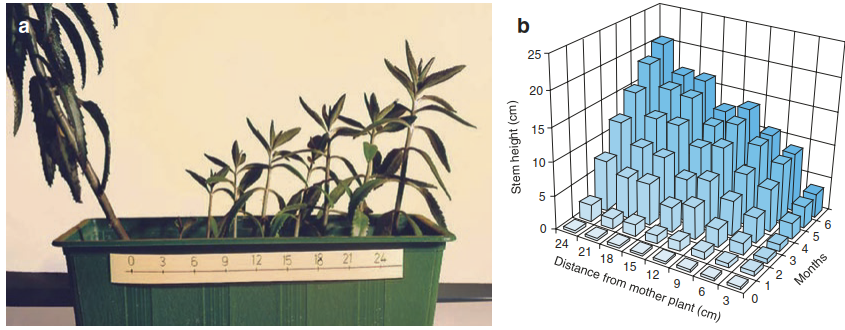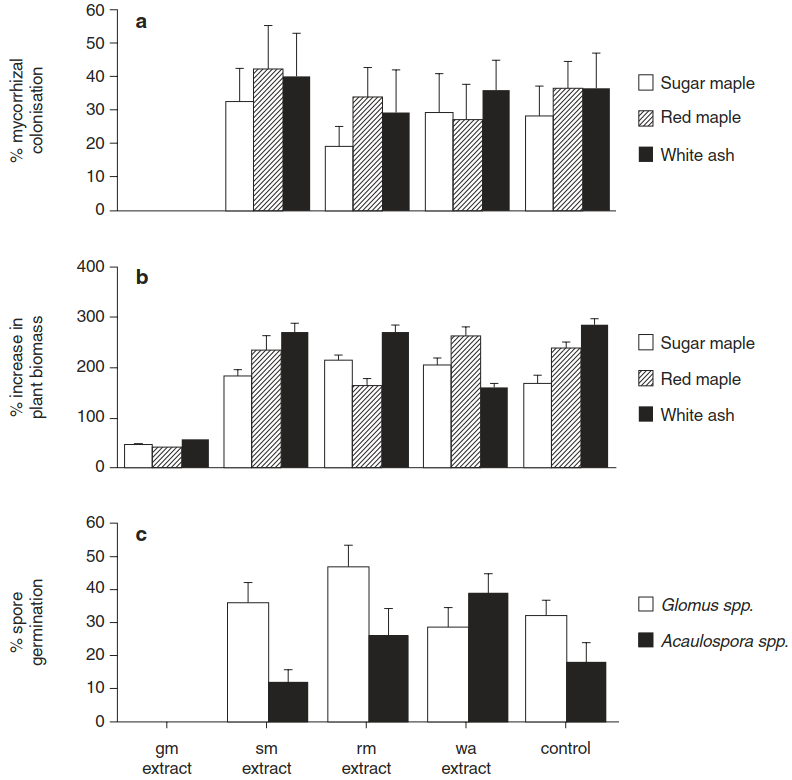Allelopathy. Definition of the Term
When one plant species inhibits the growth of another species through the production of chemicals, this is commonly referred to as allelopathy. The original definition dating back to Hans Molisch in 1937 has since been broadened to include also beneficial interactions (positive allelopathy). In accordance with the “molecular stress physiology” perspective, we will discuss only negative allelopathy—that is, a plant-plant interaction that is harmful to one of them.
Inhibition of the growth of a neighbouring plant can be beneficial because it reduces competition and increases the availability of resources. The inhibitory effect (Fig. 8.37) is achieved by the release of toxic compounds, referred to as allelochemicals, which can principally be found in leaf volatiles, in leachates from leaves, in root exudates or in decomposing tissue (Weir et al. 2004). It has, however, been notoriously difficult to ascertain that the concentrations of suspected phytotoxins are high enough in the soil to actually negatively affect the establishment or growth of neighbouring plants. Another principal challenge concerns the mode of action. What are the targets of toxicity, and how does the producing plant protect itself against the toxins? Molecularly these questions have not been answered yet.

Fig. 8.37. Intraspecific allelopathy in Kalanchoe daigremontiana. a Same-age daughter plantlets were placed in sand soil at regular intervals from the mother plant. After 150 days the height of the daughter plants clearly shows the inhibitory effect of the mother plant on their growth. b Quantification shows that the inhibition of the young plants depends on the distance from the mother plant. (After Bar et al. (2000))

Fig. 8.38. The invasive plant Alliaria petiolata (garlic mustard) inhibits plant growth by disrupting symbiotic associations between native canopy tree seedlings and below-ground arbuscular mycorrhizal fungi. The extracts of garlic mustard (gm), sugar maple (sm), red maple (rm), white ash (wa) or a water control were tested for their effects on a mycorrhizal colonisation of native tree seedlings, b biomass gain of native tree seedlings and c percentage germination of native arbuscular mycorrhizal fungi spores. The bars represent the mean and standard error (Stinson et al. 2006)
For several invasive plant species it has been proposed that part of their success is attributable to toxins in root exudates. The effect of such toxins can be indirect. An example is the release of benzyl isothiocyanates by garlic mustard (Alliaria petiolata), an invasive plant in North American forests. The exudated allelochemicals suppress the establishment of ectomycorrhizal symbioses of several tree species and thereby reduce their growth (Fig. 8.38) (Stinson et al. 2006).
References:Acevedo FE, Rivera-Vega LJ, Chung SH et al (2015) Cues from chewing insects—the intersection of DAMPs, HAMPs, MAMPs and effectors. Curr Opin Plant Biol 26:80-86
Agrawal AA, Hastings AP, Johnson MTJ et al (2012) Insect herbivores drive real-time ecological and evolutionary change in plant populations. Science 338:113-116
Agrawal AA, Konno K (2009) Latex: a model for understanding mechanisms, ecology, and evolution of plant defence against herbivory. Annu Rev Ecol Evol Syst 40:311-331
Ahuja I, Kissen R, Bones AM (2012) Phytoalexins in defence against pathogens. Trends Plant Sci 17:73-90
Alborn HT, Turlings TCJ, Jones TH et al (1997) An elici- tor of plant volatiles from beet armyworm oral secretion. Science 276:945-949
Arimura G, Ozawa R, Shimoda T et al (2000) Herbivory- induced volatiles elicit defence genes in lima bean leaves. Nature 406:512-515
Bar W, Pfeifer P, Dettner K (2000) Biochemische Interaktionen zwischen Kalanchoe-Pflanzen. Biologie in unserer Zeit 30:228-234
Barbehenn RV, Peter Constabel C (2011) Tannins in plant-herbivore interactions. Phytochemistry 72:1551-1565
Bartels S, Boller T (2015) Quo vadis, Pep? Plant elicitor peptides at the crossroads of immunity, stress, and development. J Exp Bot 66:5183-5193
Baulcombe D (2004) RNA silencing in plants. Nature 431:356-363
Bednarek P, Osbourn A (2009) Plant-microbe interactions: chemical diversity in plant defence. Science 324:746-748
Benderoth M, Pfalz M, Kroymann J (2009).
Date added: 2025-02-01; views: 329;
